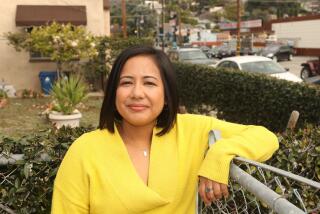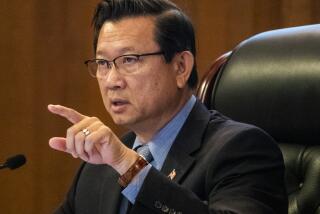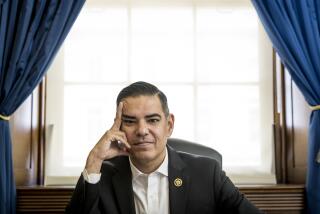Corruption Trial Pits Close Friends: Moriarty and Young
The public corruption trial that resumes this week in Los Angeles federal court focuses on the shady side of Sacramento politics and pits two close friends against each other--former fireworks manufacturer W. Patrick Moriarty and his one-time protege, Bruce E. Young.
They first met in 1971 while Young was working as a Kiwanis Club volunteer at one of Moriarty’s Red Devil Fireworks stands in Orange County, Moriarty said last week as the trial opened. Over the years, according to associates, they had a “father-and-son” relationship.
But prosecutors contend that the relationship had its roots in politics and money. Elected to the California Assembly in 1976, Young later helped promote Moriarty’s fireworks and real estate interests. According to federal prosecutors, Moriarty’s help to Young was financial.
The two men met again last week as Moriarty, 55, now serving a seven-year prison term for fraud and corruption, testified for three days as the chief government witness in a 28-count mail fraud case charging Young with concealing income from Moriarty and a cable television firm.
“I feel bad enough about the prosecution,” Moriarty said. “I dislike testifying in this case because of Mr. Young. I particularly dislike saying anything that might hurt him.”
Nonetheless, Moriarty--who conceded that he hopes that his testimony will gain him an early release from prison--outlined a series of business dealings between the two men that paralleled Young’s rise in the Legislature and Moriarty’s interest in passage of pro-fireworks legislation.
Focus on Investment
Much of Moriarty’s testimony focused on an offer he made in 1979 to help invest $50,000 for Young, promising him only at that time that he would look for a “suitable” investment. Two years later, Moriarty said, he told Young that the investment was in a Baldwin Hills condominium project and that it would double his money--a promise Moriarty never kept.
Prosecutors said that Moriarty ultimately repaid Young for most of his original investment in a variety of ways but Young’s lawyers plan to argue that Moriarty cheated Young out of the money.
Moriarty testified that in 1981 he made similar “2-for-1” offers and lived up to them with other investors--including Assembly Speaker Pro Tem Mike Roos (D-Los Angeles), who was then Assembly majority leader. He helped Roos obtain a $50,000 bank loan secured by his campaign funds, Moriarty said, and later paid him $100,000 on the investment.
Moriarty said that he was anxious to meet with Roos in 1981 and that Young helped recruit Roos as an investor. By that time, Moriarty had decided to push for legislation that would have prevented California cities from outlawing so-called “safe-and-sane” fireworks--the non-explosive type sold by his Red Devil company.
The pro-fireworks legislation narrowly passed both houses of the state Legislature, but was vetoed by Gov. Edmund G. Brown Jr. in 1982. It would have permitted Moriarty’s Pyrotronics Corp. to operate in such major cities as Los Angeles and would have doubled his business from $8 million to $16 million a year, Moriarty testified.
While focusing primarily on his business dealings with Young, Moriarty’s testimony was sprinkled with references to California politicians--including Assembly Speaker Willie Brown (D-San Francisco)--who was named in a 1982 letter from Young to Moriarty which requested $18,500 in political contributions for six Democratic Assembly candidates.
The money was later passed along to other candidates but Moriarty never was identified in public reports as the source of the money.
Brown Rebuts Allegation
Moriarty said Young told him that Brown had asked Young to request the contributions, but Moriarty was not asked whether Brown actually did make the request. While Moriarty said outside the courtroom that he assumed that Brown knew about it, Brown’s response in Sacramento was that he had no recollection of such a request.
The Young trial, expected to last a month in the courtroom of U.S. District Judge Dickran Tevrizian, has been watched closely by Sacramento politicians because of what it might reveal about the continuing Moriarty investigation, which is now focusing on a number of California politicians--including Roos.
The investigation--which started in 1983 as a probe by the Orange County district attorney’s office--already has led to the convictions of 11 former local politicians, bankers and Moriarty aides linked to the ex-millionaire’s many political and real estate ventures.
Orange County authorities sought the help of the U.S. attorney’s office as the investigation grew, and the probe is now headed by Chief Assistant U.S. Atty. Richard E. Drooyan and Chief Assistant Orange County Dist. Atty. Michael R. Capizzi, who has been appointed a special federal prosecutor to help with the case.
While calling Moriarty as the first government witness, Drooyan and Capizzi backed away last week from one of the most potentially explosive facets of the Young case--allegations that Moriarty provided prostitutes as well as cash to Young and other politicians.
There was no mention in Drooyan’s opening statement of Young’s admitted involvement with a prostitute, nor was Moriarty asked any questions about providing prostitutes to political figures.
Tactic Could Backfire
The government would not rule out any future testimony on the subject. But sources indicated that Drooyan feels that calling prostitutes as witnesses against Young will be unnecessary in obtaining a conviction and could possibly backfire by further staining the image of the government’s star witness, Moriarty.
Young, who has been represented by six lawyers during various stages of the case, decided to “take the offensive” on the prostitute issue last year while represented by Sacramento lawyer Donald Heller--calling a news conference to admit his involvement.
But San Francisco lawyers George Walker and Alan Dressler, criminal law specialists retained by Young in December, have tried to play down the sexual aspects of the case since taking over the defense. They made no effort to raise the prostitute issue during their cross-examination of Moriarty.
The government’s case against Young is based primarily on charges that he failed to report income from Moriarty and a Los Angeles cable television firm, Falcon Communications, to the state Fair Political Practices Commission, and that he violated federal mail fraud statutes by mailing checks and letters that concealed the true sources of his income.
Outlines Charges
Drooyan, outlining the key charges in his opening statement to jurors, told them that Moriarty’s financial help to Young included providing him with a leased Ford Bronco worth $500 a month in 1981 and 1982 in exchange for services as a political consultant, and paying him $6,500 to run a City Council campaign in Carson.
Other financial help provided to Young by Moriarty included the purchase of $8,500 in furnishings for a condominium owned by Young, and monthly support payments of $1,200 to Young’s former wife, Jo Ann, Drooyan said.
The prosecutor said Young set up a consulting company called Young Thinking Inc., in 1981 and represented two cable television companies in addition to Moriarty. Drooyan said Young accepted a $10,000 payment from Rogers Cable Television of Toronto, Canada, in 1981 and also received $1,000 a month for 22 months as a consultant to a Los Angeles cable firm, Falcon Communications.
Drooyan said Young did very little consulting work for the cable television firms, but was involved in efforts to deregulate the cable television industry. The prosecutor said the payments he received were processed through as many as four different bank accounts to hide Young’s relationship with the companies.
‘Never Disclosed’ Money
“Young never disclosed the money he got from Moriarty, Falcon or Rogers,” Drooyan said.
The first two mail fraud counts against Young allege that he failed to report his financial relationships in 1981 and 1982 when he filed the Statements of Economic Interest the law requires of legislators. The next 16 counts pertain to his alleged fraudulent use of the Ford Bronco from September, 1981, to December, 1982.
Seven counts in the indictment relate to the monthly $1,000 payments from Falcon Communications for consulting work and three are for failing to accurately report identities of political contributors to the campaigns of Young and Assembly members Charles Calderon and Maxine Waters, both Los Angeles Democrats, in 1982.
While declining to make an opening defense statement, Young’s lawyers responded to the charges last week at a series of daily news conferences outside the U.S. Courthouse in which they repeatedly stated that the trial will prove that Young is innocent.
‘He’s Not Guilty’
“If people are patient and wait until Mr. Young takes the stand, they will see that he’s not guilty of any federal crime,” Walker said.
Walker, 63, and Dressler, 41, said they were recommended to Young by a state prosecutor in Sacramento and have no connections to other California politicians who have been linked to the Moriarty investigation. Young said he is paying their fees himself and has already paid them $25,000 and given them a lien on his house.
Young, 40, now a Sacramento lobbyist, was a sports writer for the Long Beach Press Telegram and a marketing executive for A&W; Root Beer, Walt Disney Productions and Disneyland before entering politics.
He resigned from the Assembly in 1984 while chairman of the Assembly Transportation Committee and assistant majority leader. He had been fined a record $13,000 by the Fair Political Practices Commission the previous year for concealing more than $40,000 in campaign contributions. Young also had been named in news accounts of the brewing Moriarty scandal but cited family reasons for quitting the Legislature.
While he was an assemblyman, Young built a reputation as one of the Legislature’s top political fund raisers. According to Legi-Tech, a legislative information-gathering service, he reported amassing contributions totaling $665,756 from 1981 to 1984.
More to Read
Sign up for Essential California
The most important California stories and recommendations in your inbox every morning.
You may occasionally receive promotional content from the Los Angeles Times.










